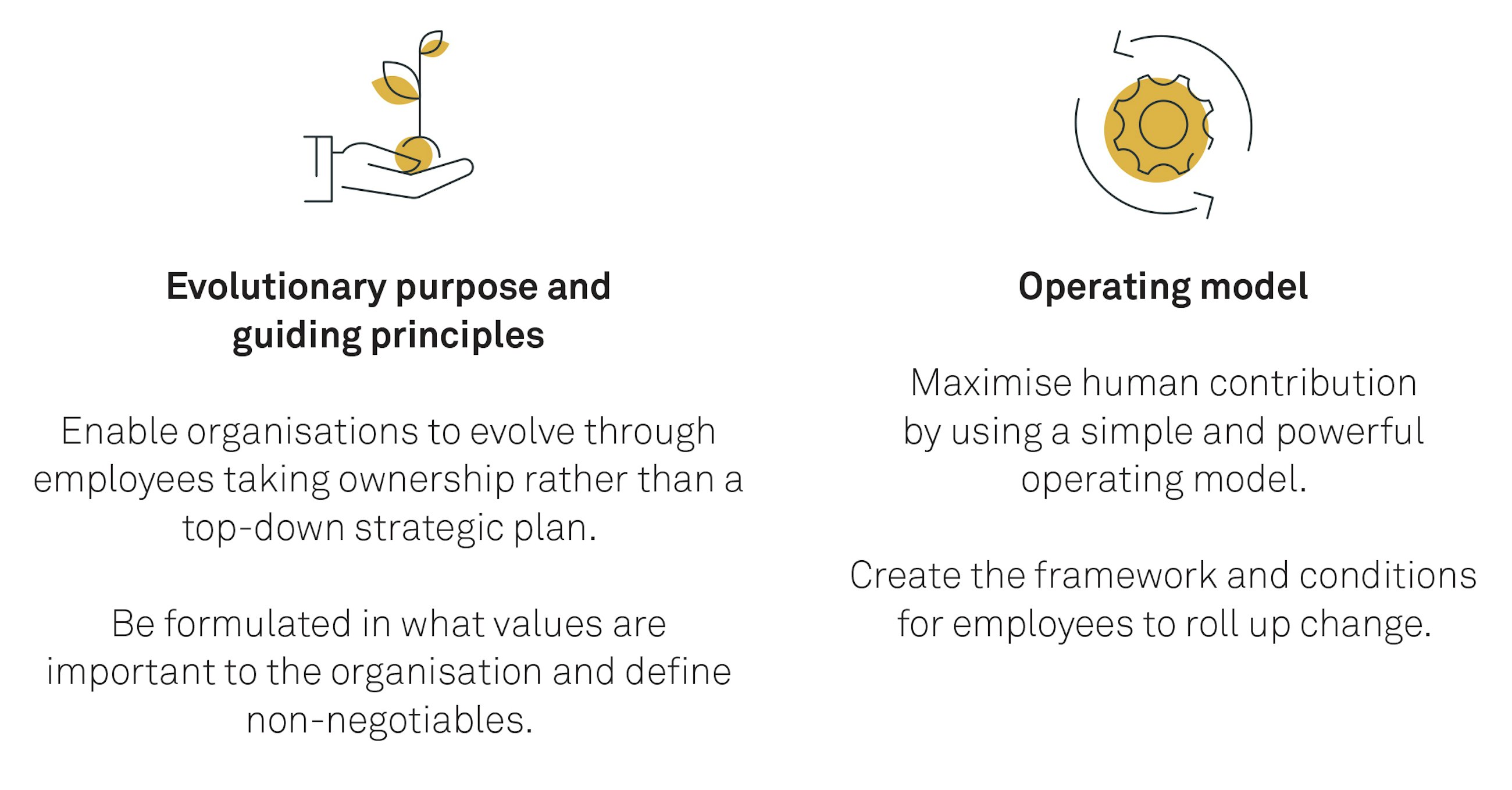– and eliminating top-down KPIs
28 May 2021
Traditional strategy execution, decision structures and KPI measures lead to sub-optimisation and often fail to create a link to the overall strategy. These structures are suited for bureaucracy and non-complex slow-changing environments. But the world is changing faster, companies become more complex, and decisions are required to be taken instantaneously within all layers of the organisation.
How to set direction and secure performance in a human-centric company
We believe that organisations with an evolutionary purpose and supporting guiding principles form a new era in organisational leadership. To succeed, organisations need to have a simple and trust-based operating model.
Evolutionary purpose is more than a static purpose statement
An evolutionary purpose is dynamic, living and constantly in motion. It is a much more profound shift in perspective. It asks us to truly see the organisation as a living entity with its own energy and sense of direction. And it therefore forces us to stop trying to predict and control the future but instead continuously become more informed and respond to the organisation’s purpose.
Imagine a power plant with the following evolutionary purpose: power to everyone as environmentally friendly as possible.
Translated to: affordable power, continuously trying to make more with the same or fever resources, limit emission etc. A mindset driving decisions and priorities for every employee within the organisation.
Evolutionary purpose – not one-size-fits-all
An evolutionary purpose cannot stand alone. Some structure and direction are needed to ensure a common understanding of values and a sense of belonging. The Dutch healthcare company, Buurtzorg, is a textbook example of how this approach has materialised into a success story. Their values are:
- People want control over their own lives for as long as possible
- People strive to maintain or improve their own quality of life
- People seek social interaction
- People seek “warm” relationships with others
These guiding principles permeate the organisation that otherwise has free rein on how to act by these values. Buurtzorg has succeeded in creating a healthcare organisation which outperforms on all parameters compared to Buurtzorg’s peers – this is achieved without top-down cascaded KPIs.
Having formulated what is important for the organisation is key to ensure a common understanding of great decision-making.
Simplicity through an operating model
Finally, we suggest a simple operating model to facilitate and enable human-centric ways of working. Ways that allow people to think and act while removing or limiting “noise” around them. For example, avoiding generating KPIs for reporting without any further actions. The operating model can include everything from standards on how to conduct meetings to IT systems supporting a platform for knowledge sharing. In fact, most of the classic Lean/TPS tools and methods can be used. Common for all is that self-managing teams form the basis of the ways of working.
There are various examples of companies that have managed to succeed with a simple and effective operating model. They do so by either following a strict concept such as Holacracy1 or by developing their own, such as the music platform Spotify2, metal producer Favi3 and the tomato producer Morning Star4. At Morning Star, they have created a simple model that can be accessed via the internet. It explains their common vision, mission and way of working5. An example is their description of how you can make decisions. The rule is as follows:
Before making decisions or acting, you should coordinate with colleagues when:
- Colleagues are likely to be meaningfully affected.
- Colleagues’ input brings additional meaningful knowledge and expertise
If, for example, a blue-collar worker on the shop floor thinks it is a good idea to buy new equipment, he or she can do so if they consult with colleagues, which fulfils the two bullets above. This effectively means no complex approval systems and finance controls etc. It is simple and requires trust in the employees.
Is it the end of KPIs?
We do not suggest eliminating KPIs. Simply adjust the KPIs and the way that KPIs are being used.
Imagine a self-managing team working in a factory. What would happen if they did not have any metrics to steer by? For example, lead time, inventory levels, spend, customer satisfaction, spare parts, maintenance. They would be operating in the blind. Transparency and ownership are key to ensure a business understanding throughout the organisation. There is no harm in letting the teams work with KPIs and setting goals for the team.
We suggest two non-negotiables when working with KPIs in future organisations:
- KPIs are created by the teams and rolled up: As explained above, the level of complexity, speed, risks and opportunities will never be captured from a top-down perspective.
- KPIs are at team level, not individual level: We firmly believe that the purpose of great KPIs is to provide business insights. The purpose is not to motivate people to reach a certain individual target on performance. This way of driving incentives is old-fashioned and unnuanced. We believe that most people are fundamentally motivated to do a good job, including driving the business forward and being a helpful and caring colleague. Therefore, the KPIs must never take focus away from the individual’s performance.
Successful human-centric organisations have a few things in common
In a human-centric organisation, the entire organisation is moving towards the same destination, and that destination is where the business objectives, capabilities and customer needs intersect. This is a critical foundational block which is not always laid as effectively as it needs to be to ensure a successful transformation to a human-centric organisation.
A human-centric organisation embraces the notion of engaging the customers, colleagues and partners (e.g. suppliers) in creating new solutions, products and services and testing them. For this to be possible, the human-centric organisation celebrates failures and has a culture where failing fast and improving are nurtured.
Human-centric organisations nurture a culture in which every single individual, including the top leadership of the organisation, must manifest and model it all day every day.
Sources
2 https://www.spotifyjobs.com/culture/the-band-manifesto
3 http://www.favi.com/en/about-favi/
4 https://www.morningstarco.com/careers/
5 https://www.honeystreet.com/clients/morningstarco/overview/8-11-20/index.html





